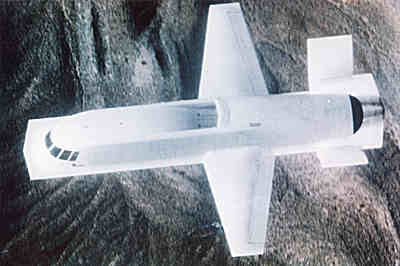
United States Air Force(www.af.mil)

| Aircraft | B-2 "Spirit" (Northop Grumman Corp.) |
| Type | Low-observation strategic penetration bomber |
| Year | December 1993 |
| Engine | Four General Electric F-118-GE-100 engines: 17,300 pounds of thrust each |
| Wingspan | 172 feet (52.12 meters) |
| Length | 69 feet (20.9 meters) |
| Height | 17 feet (5.1 meters) |
| Weight | 336,500 pounds (152,635 kilograms) |
| Max. speed | 140 knos |
| Range | over 10,000 nm (with mid-air refueling) |
| Crew | 2 |
| Armament | 16 AGM-131 SRAM II :up to 22,680kg
16 AGM-129ACMs:up to 22,680kg 16 AGM-137 TSSAMs:up to 22,680kg 16 B61:up to 22,680kg 16 B83 stratgic nuclear free-fall bombs:up to 22,680kg 36 M117 750lb fire bombs:up to 22,680kg 36 CBU-87/89/97/98 cluster bombs:up to 22,680kg 80 Mk 62 sea mines:up to 22,680kg AGM-86 Air Launched Cruise Missile :up to 22,680kg |
The B-2 Spirit is a multi-role bomber capable of delivering both conventional and nuclear munitions. A dramatic leap forward in technology, the bomber represents a major milestone in the U.S. bomber modernization program. The B-2 brings massive firepower to bear, in a short time, anywhere on the globe through previously impenetrable defenses.
Along with the B-52 and B-1B, the B-2 provides the penetrating flexibility and effectiveness inherent in manned bombers. Its low-observable, or "stealth," characteristics give it the unique ability to penetrate an enemy's most sophisticated defenses and threaten its most valued, and heavily defended, targets. Its capability to penetrate air defenses and threaten effective retaliation provide a strong, effective deterrent and combat force well into the 21st century.
The revolutionary blending of low-observable technologies with high aerodynamic efficiency and large payload gives the B-2 important advantages over existing bombers. Its low-observability provides it greater freedom of action at high altitudes, thus increasing its range and a better field of view for the aircraft's sensors. Its unrefueled range is approximately 6,000 nautical miles (9,600 kilometers).
The B-2's low observability is derived from a combination of reduced infrared, acoustic, electromagnetic, visual and radar signatures. These signatures make it difficult for the sophisticated defensive systems to detect, track and engage the B-2. Many aspects of the low-observability process remain classified; however, the B-2's composite materials, special coatings and flying-wing design all contribute to its "stealthiness."
The B-2 has a crew of two pilots, a pilot in the left seat and mission commander in the right, compared to the B-1B's crew of four and the B-52's crew of five.
The first B-2 was publicly displayed on Nov. 22, 1988, when it was rolled out of its hangar at Air Force Plant 42, Palmdale, Calif. Its first flight was July 17, 1989. The B-2 Combined Test Force, Air Force Flight Test Center, Edwards Air Force Base, Calif., is responsible for flight testing the engineering, manufacturing and development aircraft as they are produced. Three of the six developmental aircraft delivered at Edwards are continuing flight testing.
Whiteman AFB, Mo., is the B-2's only operational base. The first aircraft, Spirit of Missouri, was delivered Dec. 17, 1993. Depot maintenance responsibility for the B-2 is performed by Air Force contractor support and is managed at the Oklahoma City Air Logistics Center at Tinker AFB, Okla.
The prime contractor, responsible for overall system design and integration, is Northrop Grumman's Military Aircraft Systems Division. Boeing Military Airplanes Co., Hughes Radar Systems Group and General Electric Aircraft Engine Group are key members of the aircraft contractor team. Another major contractor, responsible for aircrew training devices (weapon system trainer and mission trainer) is Hughes Training Inc. (HTI) - Link Division, formerly known as CAE - Link Flight Simulation Corp. Northrop Grumman and its major subcontractor HTI, are responsible for developing and integrating all aircrew and maintenance training programs.
Source-United States Air Force


Northrop Tacit Blue
United States
Nominated by the staff of the Air Force Flight Test Center History
Office at California's Edwards Air Force Base.
An experimental stealth technology (later develpoled
into the B-2 "Spirit") demonstrator flown in the
mid-1980s, Tacit Blue's bloated appearance earned
it the nickname Whale. "You look at the plane and
say, 'Wow, that doesn't look very aerodynamic,' "
said Air Force test pilot Ken Dyson. "Then you look
at the aerodynamics of it and you say, 'Wow, that
doesn't look very aerodynamic.' " Dyson added that
Tacit Blue lived up to its other nickname, HUM, for
Highly Unstable Mother. "I can't believe how many
times I crashed it in the simulator," he said.